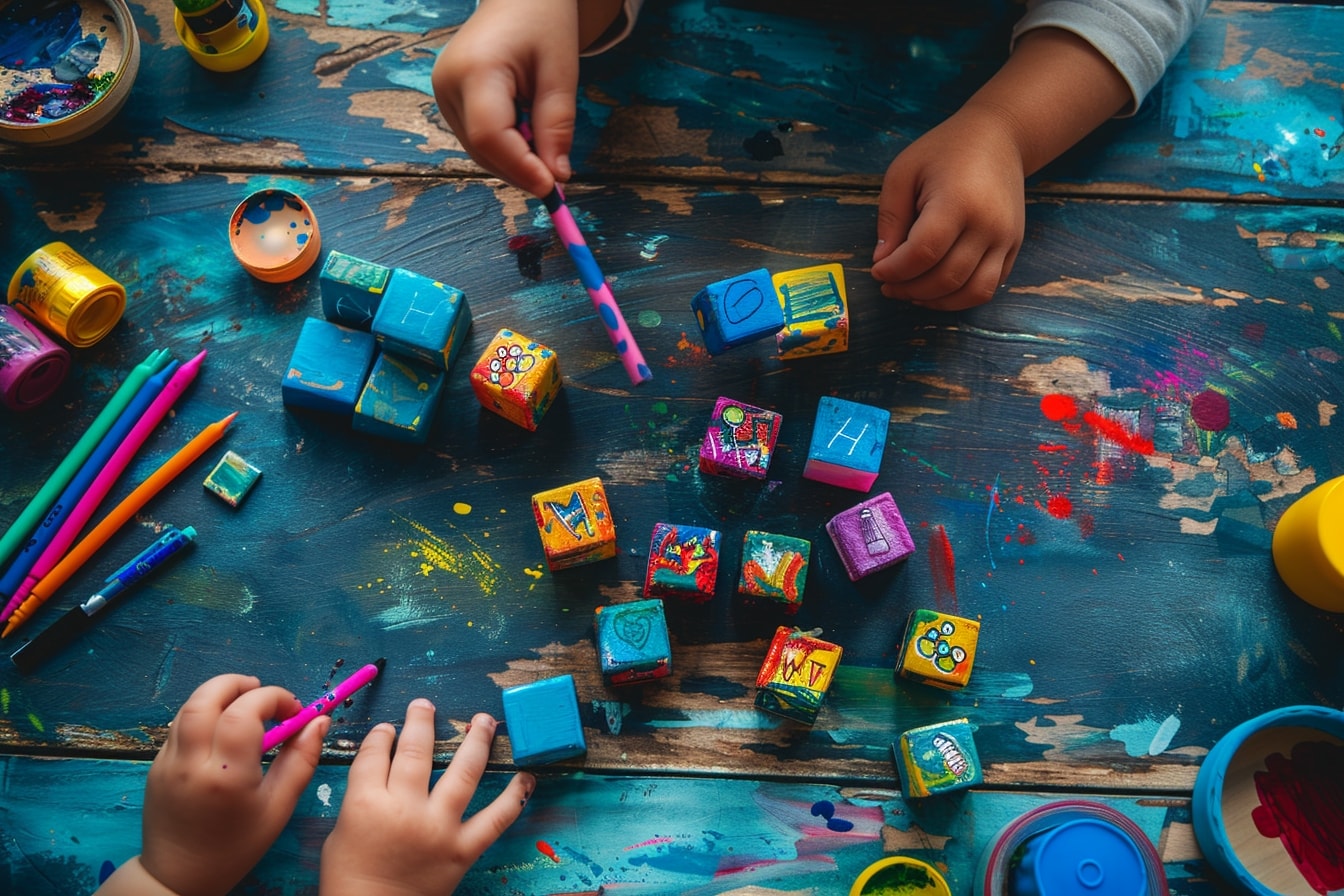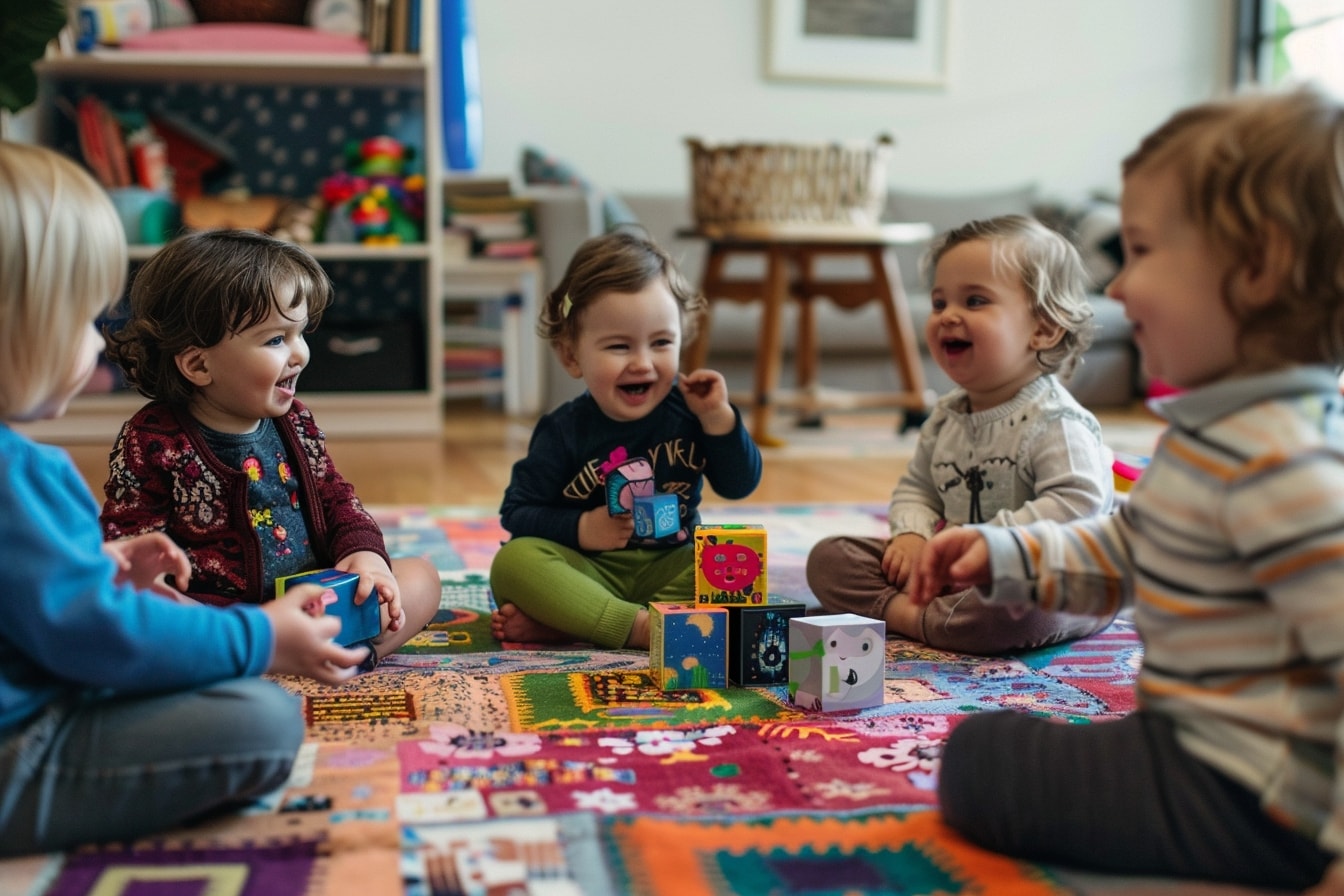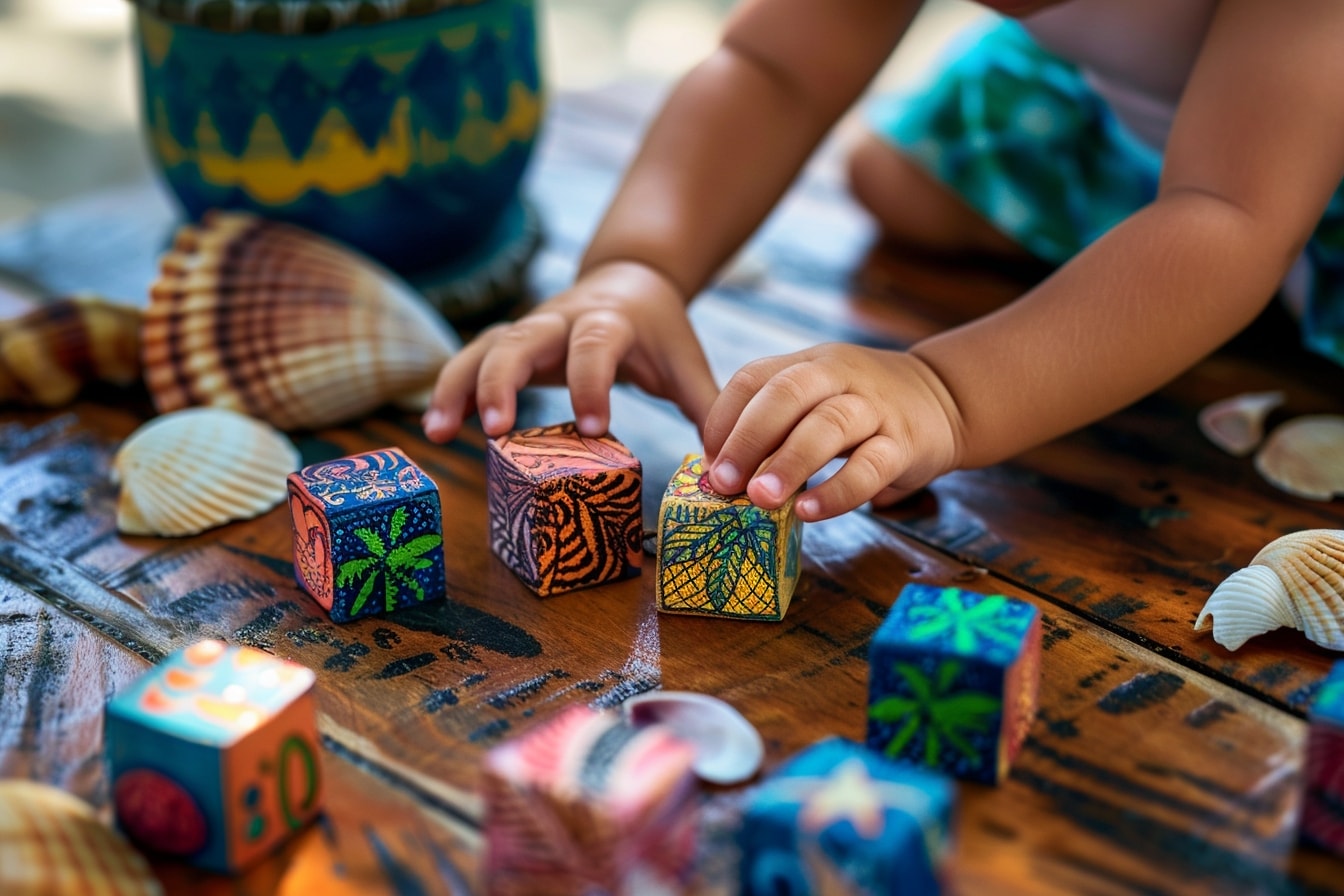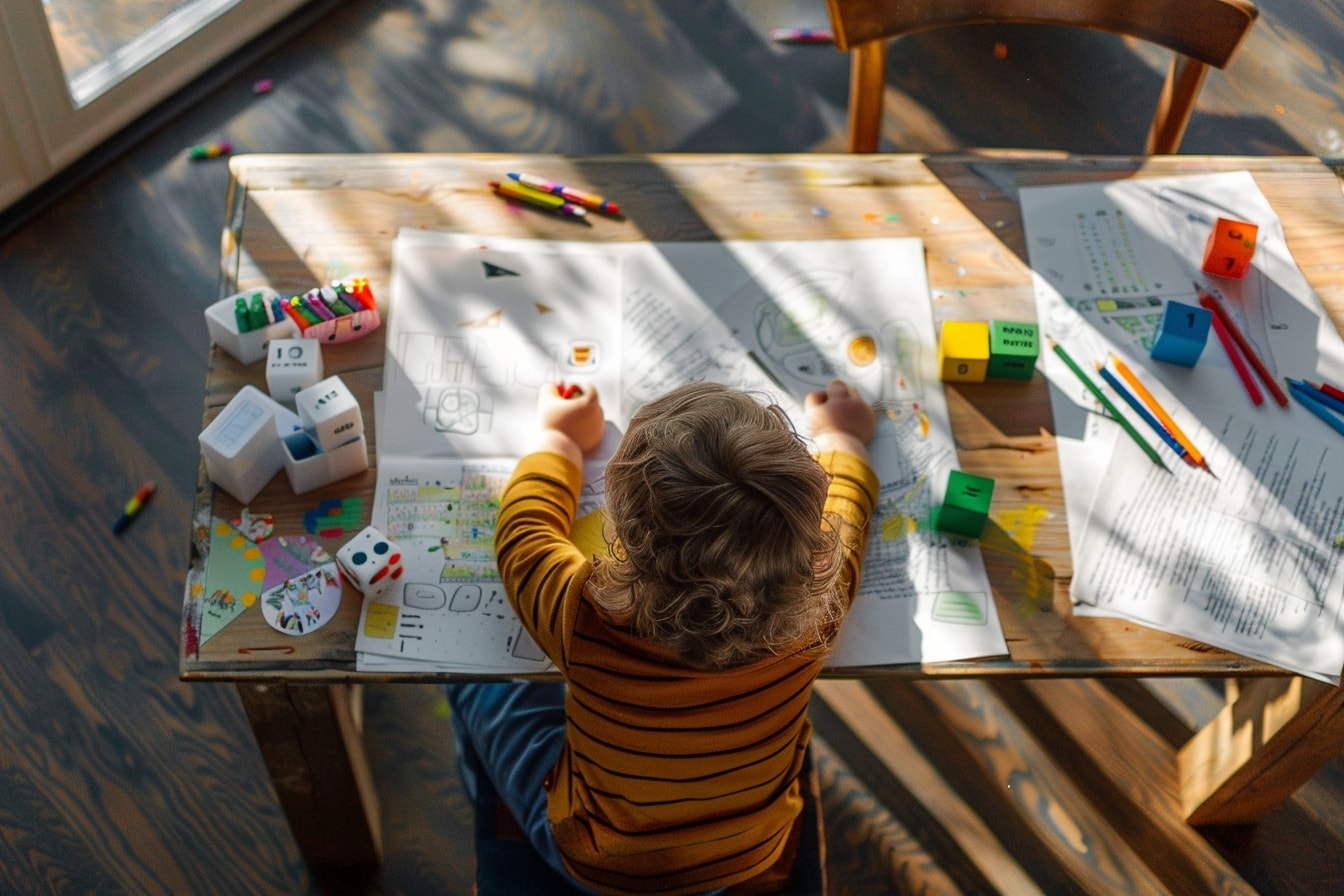Table of Contents
ToggleDIY Toddler Story Cubes: Create Your Own Adventure
Yesterday is gone and tomorrow isn’t guaranteed. The only moment we truly have is now—and in this moment, you hold the power to unlock something extraordinary in your child’s developing mind. Not through expensive apps or complicated programs, but through something so simple it seems almost impossible.
Think about this: when people face their final moments, they don’t wish they’d bought more educational toys. They don’t regret missing that latest parenting trend. No, they wish they’d lived more authentic moments, created more genuine connections, expressed their creativity freely. And here’s the profound truth that changed everything for me—your child is already living this way, until we unknowingly train it out of them.

Designing Your Story Cube Templates
The path you’re about to embark on isn’t something you can see from the start. You create it by walking, by doing, by learning from each small step. Yes, that first cut of paper, that first fold, might feel insignificant. You might wonder if you’re wasting time on something so simple. But here’s what I discovered after years of watching families transform…
Choosing Themes and Imagery
Every image you choose is planting a seed in your child’s consciousness. Not just any seed—but one that will bloom into stories they’ll remember decades from now. Consider this carefully:
- Palm trees aren’t just trees—they become secret hideouts where pirates buried treasures of imagination
- Sea creatures transform into guides through underwater kingdoms of possibility
- Simple shapes become portals to worlds where your child is the hero, the creator, the master of their narrative
Name 5 objects in your room right now. Got them? Each one could become a story cube image that generates 100+ unique story combinations. The magic isn’t in perfection—it’s in personal connection.
Embracing Color and Simplicity
When you start before you’re ready, something powerful happens. You build momentum. Every tiny step—choosing that bright yellow over pale beige, drawing that wonky circle that becomes a sun—makes you more capable, more confident. It’s a vote you cast for the creative parent you’re becoming.
- Use contrasting colors (your child’s brain processes these 3x faster)
- Keep it simple—complexity is the enemy of imagination
- Add texture with basic patterns—dots, stripes, squiggles activate different brain regions
Adding Personal Touches
Here’s where most parents stop. They download a template, print it out, done. But you’re not most parents, are you? You understand that these cubes aren’t just toys—they’re time machines that will transport your child back to this moment, this connection, years from now.
- That photo of grandma becomes a character who lives forever in stories
- Your child’s scribbled drawing of the family dog becomes an adventure companion
- A simple handprint becomes a magic portal to anywhere

Assembling and Decorating Your Story Cubes
The 5-Minute Miracle Timer
Studies show: 5 minutes of hands-on creating = 30 minutes of passive screen learning
The pain of feeling stuck is always worse than the pain of taking action. Every day you wait to create these simple cubes is a day further from the connection you’re craving with your child. But when you start—even imperfectly—transformation begins.
Materials Needed
Forget the Pinterest-perfect supplies list. Here’s the truth nobody shares:
- Paper (even junk mail works—one parent used old cereal boxes and created magic)
- Scissors (safety ones mean your toddler can help)
- Tape or glue (stick glue = less mess = more fun)
- Markers, crayons, anything that makes marks
- Optional: That laminator gathering dust? Now’s its moment!
Assembly Instructions
- Cut – Imperfect edges tell better stories than machine-cut precision
- Fold – Each crease is a decision to invest in your child’s imagination
- Glue – Messy glue spots become “battle scars” in future story adventures
- Press – Your child’s tiny hands helping here create ownership
- Wait – The hardest part, but anticipation doubles the eventual joy
Decorating Techniques
This is where you stop being a parent doing a craft and become a memory architect. Every stroke of color, every sticker placed, is building a foundation of creativity that compounds daily.

Playing with Story Cubes: Creative Storytelling
Now we arrive at the moment everything changes. Not next week when you “have more time.” Not after you’ve practiced. Right now, with whatever imperfect cubes you’ve created, magic begins.
Cube 1: A tree | Cube 2: A rainbow | Cube 3: A shoe
Your brain just created at least 3 different story possibilities in under 2 seconds. That’s the power you’re unlocking in your child—multiplied by their limitless imagination.
How to Play
Forget the rules. Seriously. The moment you say “you’re doing it wrong,” you’ve lost. Instead, embrace this truth: every single way your child plays with these cubes is right. Every nonsensical story, every impossible adventure, every silly voice—all of it is building critical thinking disguised as play.
- Roll the cubes (or gently toss—chaos creates better stories)
- Look at what lands face-up (no re-rolls—constraints breed creativity)
- Start anywhere (middle, end, wherever feels right)
- Say “Yes, and…” to every idea (this is improv training disguised as parenting)
- Keep going until natural end (or bedtime, whichever comes first)
Game Variations
- Lightning Round: 30-second stories build quick-thinking muscles
- Reverse Engineering: Start with ending, work backward (builds logical sequencing)
- Silent Stories: Act it out first, narrate after (engages multiple intelligences)
- Story Telephone: Each person adds one sentence (teaches active listening)
Benefits of Storytelling
What if I told you that every minute spent playing with these cubes is depositing compound interest in your child’s future? Not metaphorically—literally. The neural pathways formed during creative storytelling become the highways for future learning, relationships, and resilience.
- Language Development: 1,000+ new word connections per session
- Emotional Intelligence: Processing 50+ emotional scenarios safely
- Problem-Solving: Creating solutions to impossible situations builds real-world adaptability
- Confidence: Every story told is proof they have something valuable to share

Incorporating Caribbean Culture into Storytelling
Your heritage isn’t just history—it’s a superpower waiting to be activated in your child’s imagination. Every cultural element you weave into these stories plants seeds of identity that will bloom when they need them most.
Exploring Caribbean Folklore
Anansi isn’t just a spider—he’s a teacher of cleverness over strength. The soucouyant isn’t just scary—she teaches discernment. Every folklore character carries generations of wisdom, compressed into stories that stick.
- Make Anansi a problem-solving coach in modern adventures
- Transform jumbies into silly friends who help find lost toys
- Let traditional songs become magic spells in your stories
Celebrating Caribbean Landscapes and Wildlife
That beach isn’t just sand—it’s where mountains decided to rest. That parrot doesn’t just squawk—it carries messages between story worlds. You’re not just describing nature; you’re downloading an entire ecosystem into your child’s imagination.
Embracing Caribbean Festivals and Traditions
Carnival becomes a parade of possibilities. Each costume is a character, each drum beat moves the story forward. You’re teaching rhythm, pattern, celebration—all disguised as play.

Enhancing Learning and Development
- 📅 Day 1-30: Your child starts connecting random images into sequences
- 📅 Day 31-60: Complex narratives emerge, vocabulary explodes
- 📅 Day 61-90: Problem-solving in daily life mirrors story solutions
Parents report: “It’s like watching their brain level up in real-time.”
Language Development
Here’s what nobody tells you: your child’s brain is desperately searching for patterns, connections, meaning. Every story created feeds this hunger, but not equally. Interactive creation beats passive consumption 10:1. Those stammered, imperfect stories your child tells? They’re worth more than any perfectly narrated audiobook.
Critical Thinking Skills
When your child says, “But what if the dragon was actually scared?” they’ve just performed complex perspective-taking that many adults struggle with. This isn’t just cute—it’s revolutionary brain development happening in real-time.
Social and Emotional Development
Every villain who becomes a friend, every problem solved with kindness, every silly voice that makes everyone laugh—these aren’t just moments. They’re emotional intelligence workshops where failure is impossible and growth is guaranteed.
Your Journey Starts Now
You’ve discovered that six simple cubes can transform your child’s neural development. You’ve learned that imperfection beats perfection. You know that 5 minutes today compounds into years of advantage.
The only question left: Will you start before you’re ready, or wait for a perfect moment that never comes?
Make that first cut. Fold that first edge. Roll those first cubes. Because I guarantee you, if you wait too long, the only regret you’ll have is that you didn’t start earlier.
Your child is waiting. Not for perfect cubes, but for imperfect moments of connection. Not for flawless stories, but for fumbled adventures you figure out together. Not for you to be ready, but for you to be present.
The magic is in the here and now. And now, you hold six cubes of possibility.
Go create your first story. The imperfect, messy, absolutely perfect story that only you and your child can tell.
Want to take your knowledge to the next level? Check out these must-read articles:

